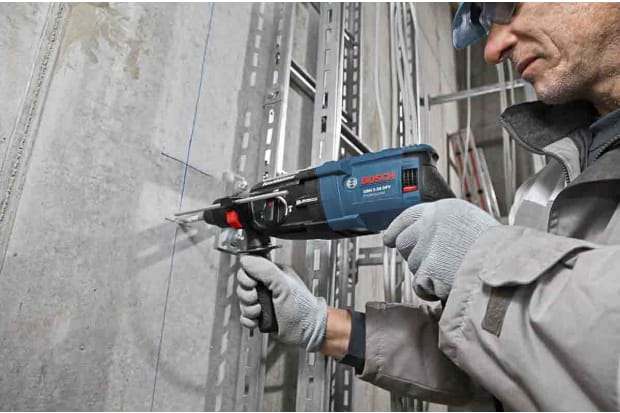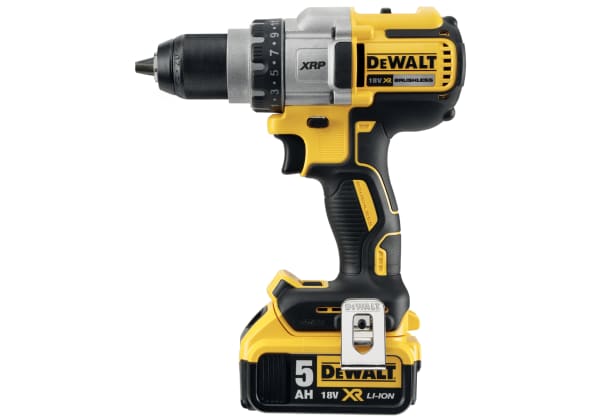- Published 11 Jan 2023
- Last Modified 29 Aug 2023
- 7 min
A Complete Guide to SDS Drills
Our guide explains how SDS drills work, what they do, and their most common uses.

What is an SDS Drill?
SDS drills, also known as chisel or hammer drills, are a powerful type of hammer tool best suited to heavy-duty drilling applications. These specialist power tools can be used to drill through materials such as steel, brick, masonry, and concrete, making them handy tools for a range of tasks.
These tools combine the hammer action of a standard hammer drill with the rotary motion of regular drills, making them highly beneficial, effective power tools.
What Does SDS Stand for?
Interestingly, there is no definitive answer to this question. However, the most widely accepted theory is that SDS is a simple acronym for ‘Slotted Drive System’.
An interesting alternative is that the name derives from the original German phrase ‘steck, dreh, sitzt’ (insert, twist, fits).
How Do SDS Drills Work?
SDS hammer drills feature a slotted drive system, meaning that the chuck is designed to fit specialist SDS drill bits. These have slots or indentations at the end of their shanks, ensuring a seamless fit into the chuck.
When in operation, the hammer action thrusts the bit forwards. Crucially, the bit’s slots also feature a pair of sprung ball bearings. These bearings are housed in the slots on the bit and act as a sort of safety mechanism, ensuring the bit stays fitted in the chuck. The indentations also help to permit the back and forth hammer action.
The hammer motion is driven by a piston, which fires the bit forward before pulling it back again in a concentrated motion. SDS hammer drills need to have a high level of strength to perform heavy-duty drilling applications, and the smooth action of the ball bearings in the bit help to boost the drill’s strength while also working to reduce friction levels.
How Do You Use an SDS Drill Safely?

As is the case when using power tools of any kind, you must ensure that you are fully aware of the relevant safety guidelines before operating the device. It is essential that you ensure both the drill and the bit/s are in good working order – perform a visual inspection before use and if in doubt, do not use the part. You should also make sure to use the correct bit for the task and ensure it is securely fitted into the chuck prior to operation.
Consideration should also be taken with regards to the environment and drilling location, as well as the material you will be drilling. Not only will this help to inform the best type of bit for the task, but it will also determine any additional safety precautions you may need to take.
Lastly, never operate a drill without the correct PPE. Personal protective equipment is essential for keeping you safe while you work, and the importance of this should not be overlooked. The PPE you need when operating a drill includes:
SDS Drill Maintenance Tips
All power tools need semi-regular maintenance to perform optimally and prolong their working life. The following tips should help you keep your tool in good working order:
- Always follow the manufacturer’s guidelines for usage and maintenance and be sure to familiarise yourself with any warning signs the drill might have
- Replace any damaged drill bits as soon as possible as using them could end up damaging the drill itself
- Remove any debris from the end of the bit after use
- Wipe the end of the bit before fitting into the chuck to ensure a secure hold and to prevent any dirt or dust from causing issues with the mechanism
- You may find it beneficial to grease the bit shank before fitting into the chuck to help prevent jamming. Take care not to over-grease though, as this could also be problematic
Types of SDS Drills
Multiple different types of SDS hammer drills are available, each with their own advantages and most suitable applications. Although these drills can be categorised in several different ways, one of the simplest is to determine whether the drill is a corded or cordless model.
The two different types are explained below:
Cordless SDS Drills
Cordless drills are often preferred due to the increased mobility and flexibility that they offer. Instead of being tethered by a cable and constrained by the proximity of a plug socket (or the length of an extension lead), you can use a cordless drill virtually anywhere. However, cordless drills run on batteries, which means you need to keep an eye on your battery power and may need to pause work to allow the battery to recharge.
Corded SDS Drills
On the other hand, corded power tools take their power from mains electricity, avoiding the time taken to recharge batteries. This also means that they need to be connected to an outlet to work, which may be problematic in certain situations. However, the key advantage of using a corded drill is that the majority of corded drills are more powerful than their cordless counterparts. Additionally, they will usually offer greater torque, too.
SDS Drills by Brand
In addition to corded and cordless models, another way to distinguish the different types of SDS hammer drills is by brand. When shopping for a drill, quality and durability should come across all else, and selecting the best model for your requirements is essential.
Browse a selection of leading brands below and click through to shop with RS.
SDS Drill Bits

Good quality bits are essential for achieving the best results in drilling applications. A wide variety of different options is available, so you must select the most suitable rotary hammer drill bit for the task at hand. You must consider the size of the bit – not only whether its diameter will fit the drill chuck, but also whether it is the right length for the required task.
Additionally, the material which the bit is made from should also play a role in your selection. Most SDS drill bits are manufactured from steel, often with various coatings and finishes applied. Popular options include carbide tipped (designed to maintain a sharper cutting edge for longer) and chrome-nickel molybdenum steel.
One final consideration to take into account when choosing a drill bit should be the brand. Many leading brands are available, offering top-quality SDS bits, but ultimately, your personal preference will depend on which manufacturer’s products you select.
FAQs
Can I Use Normal Drill Bits in an SDS Drill?
It is possible to use a standard bit with an SDS drill but using specialist SDS drill bits is always recommended where possible. It is important to note that you will need to use a chuck adaptor if you want to use regular drill bits, as the standard parts will not fit the drill chuck otherwise. Some models feature interchangeable chucks for this purpose, but others will need the addition of an adaptor.
Top Tip!
If you will be using standard drill bits with an SDS drill, you must ensure that the hammer action is disabled before use. This will avoid damaging the bit and will also help to keep you safe while operating the drill.
What is the Difference Between an SDS Drill and a Hammer Drill?
In essence, SDS drills are a type of hammer drill. However, SDS drills are more powerful than the standard hammer drill, making them well suited to more heavy-duty drilling applications. The two terms are sometimes used interchangeably, but if you need a drill for use with tough materials like concrete and masonry, an SDS drill will be the best option.


